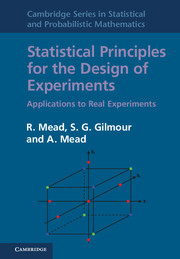Book contents
- Frontmatter
- Contents
- Preface
- Part I Overture
- Part II First subject
- Part III Second subject
- 12 Experimental objectives, treatments and treatment structures
- 13 Factorial structure and particular forms of effects
- 14 Fractional replication
- 15 Incomplete block size for factorial experiments
- 16 Quantitative factors and response functions
- 17 Multifactorial designs for quantitative factors
- 18 Split-unit designs
- Part IV Coda
- References
- Index
17 - Multifactorial designs for quantitative factors
from Part III - Second subject
Published online by Cambridge University Press: 05 November 2012
- Frontmatter
- Contents
- Preface
- Part I Overture
- Part II First subject
- Part III Second subject
- 12 Experimental objectives, treatments and treatment structures
- 13 Factorial structure and particular forms of effects
- 14 Fractional replication
- 15 Incomplete block size for factorial experiments
- 16 Quantitative factors and response functions
- 17 Multifactorial designs for quantitative factors
- 18 Split-unit designs
- Part IV Coda
- References
- Index
Summary
Preliminary examples
(a) An experiment was to be conducted to optimise the pretreatment and drying conditions for the production of high-quality potato cubes by a process of high-temperature puffing (Varnalis et al., 2004). Four treatment factors, namely the blanching time, the sulfiting time, the initial drying time and the puffing time, were to be studied. No mechanistic model for the effects of the factors was available, so as an approximation it was decided to fit a second-order polynomial response surface model. It was expected that there could be day to day differences in response, but only six runs could be made per day. Six blocks (days), each containing six experimental units (runs) was considered to be a reasonable size of experiment. Hence, a suitable set of treatments and replications has to be chosen for the 36 runs and arranged in blocks of size 6.
(b) An experiment is to be conducted to investigate the effect of the levels of two additives on the quality of a cake production process (Bailey, 1982). The resources available are 25 experimental units using the same five ovens on each of five days. The blocking structure must therefore be a 5 × 5 row-and-column design. The design choices concern the treatment levels and their replication, and particularly the pattern of allocation of treatment combinations to experimental units. There is a particular interest in the linear × linear interaction term and the linear and quadratic main effects of each factor must also be regarded as important.
- Type
- Chapter
- Information
- Statistical Principles for the Design of ExperimentsApplications to Real Experiments, pp. 448 - 474Publisher: Cambridge University PressPrint publication year: 2012
- 1
- Cited by



